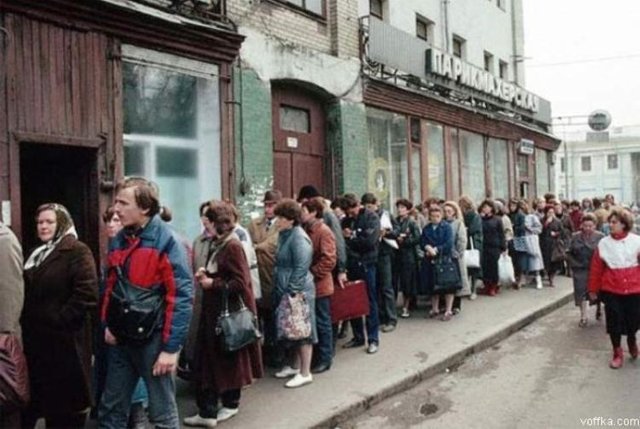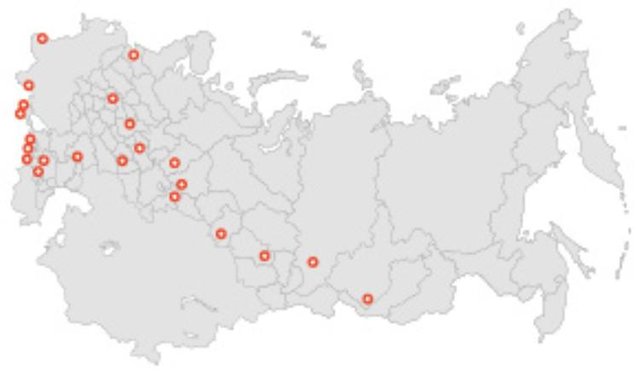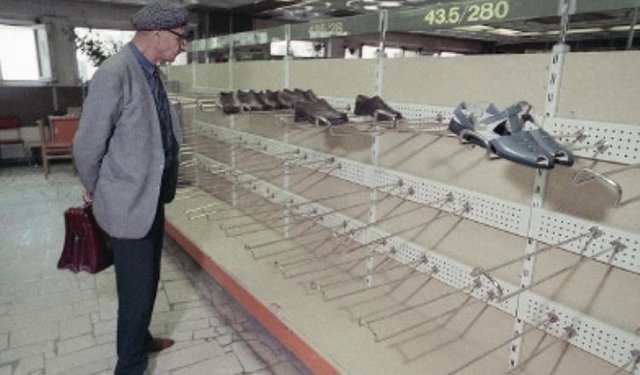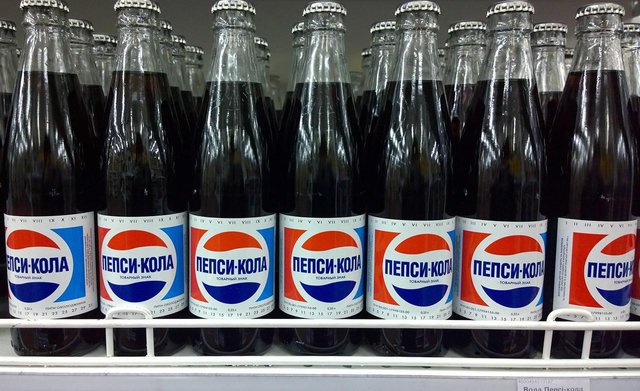The deficit in the USSR - as it was

The Soviet government is doing everything for the good of man. And you know this person. So people's memory imprinted deeply respected Leonid Brezhnev, who became in 1964, after the dismissal of Nikita Khrushchev, the first person in the state.
Anecdote quite accurately conveys the essence of the seventies era braking. New, Brezhnev elite abandoned the concept of rapid development for the sake of stability, turning to practice lag. GDP growth rate, which in the 50s averaged 8% per year, decreased by 60% to 5.5 and 70 to 4%. Accordingly, in terms of braking national product began to be distributed selectively. If caste of officials and Party workers nothing special itself did not refuse, then the rest of the country, and not having time to catch up with America, and murmur in lines composed anecdotes about socialist abundance.
The protagonist of the new era instead of the military and astronauts is the one who distributes. His Majesty the seller, store manager, or as a nationwide joke comedian Arkady Raikin, director of store. You have a lot, and I'm one favorite phrase counter worker as an honor designated sales position.
Inspiring from the victory over fascism and space wins fades into the background.
The life of the Soviet people is included in the track philistine phased acquisition dostavanie, those or other scarce items (like the Chinese concept of the three round things - watches, bicycles, sewing machine, which it is necessary to buy). Stages of consumer growth for the average Soviet citizen were as follows carpet, crystal, furniture wall, color TV and a car. Since everything is very expensive cost, consumer lending virtually non-existent and for many things over the years had to stand in line, the strategy could be developed for a long time.
The existence of an average person in a deficit like a constant hunt, those who could not be included in the VIP-distribution chain, have tried to establish useful connections everywhere. Usually it was a store manager, department heads at points of sale, supply manager. Acquisition deficiency often resembled a secret operation first call from his person, and then a rapid raid the store to there, hiding from those strolling along the empty shelves of visitors, semi-legally purchased, often without trying (when it came to clothes), lazy thing for you. On the intricacies of such a desired color or style of the question. If instead of the expected jeans were available, for example, corduroy pants, had to be happy to take what they give. Those who could not acquire useful connections in the queue. Queues another symbol of an era of general shortages. They were not so numerous and dramatic, as in the era of perestroika. However, Soviet citizens had to carry out little by little in them more and more time.
The deficit is the mover of existence. Man is an animal that wants to get it, he wants to live like imagining how to read. And in Soviet times, penetrating images of other machines and other counters. I remember the first time abroad, I went to the supermarket, very similar to today's ordinary village, and it was a shock. What's the Notre Dame which supermarket Moulin Rouge! Then all I had to get it. He took a piece of meet and ran on, still obtain. Yes, and the quality was excellent. So I went to the car victory it was made of metal here such thickness. To it came carburetor incident flux bucket of gasoline, hose under the hood of an enema, one behind the wheel, the other holding a bucket. And then all of a sudden got under the fuel pump gasket, put himself went! Happiness. And as soon as the satisfaction of owning a deficit, I do sublime. And now, when everything in the throat in a position to get that and do nothing, and so all is well. (Alexander Shirvindt)
Cities of the USSR the priority supply

Of course, the level of trade deficit in the different regions vary greatly. Each town USSR was assigned to one of the categories of supply. There have been four: special, first, second and third. For special and first category Moscow and Leningrad, large industrial centers, as well as Soviet republics such as Lithuania, Latvia, Estonia and resorts of national importance, such as the Caucasian Mineral Waters. Residents of these industrial centers were eligible to receive funds from the central supply of bread, flour, cereals, meat, fish, oil, sugar, tea, eggs in the first place and at higher rates. Consumers are special and the first lists were approximately 40% of all supplied with a deficit, but received the lion's share of public procurement 70 80%. With the exception of megacities, the average of the worst food and industrial goods was supplied with exactly the RSFSR population.
Thus the center of buying the loyalty of the Union republics. Those who lived in small towns, had to settle for a very meager list of goods. In the framework of the planned distribution of the economy situation is often brought to the absurd. For example, in the town of Yuriev-Polsky Vladimir region, where he spent his childhood the author of these lines, in Soviet times, worked on local raw materials largest meat-packing plant. However, residents of the city, at least mortals, production is not reached. It was distributed to other cities in the area are a higher category of supply.
It is no secret that the highest standard of living in the Soviet Union was in the republics of the Caucasus and the Baltic states. Take for example the main fetish of the Soviet-era private car shortages. If in 1985 the RSFSR motorisation rate was 44.5 cars per thousand population (and mostly at the expense of Moscow, Leningrad and southern regions), in Georgia, the figure was 79 and in the Baltic States 80 110. Today, the level of car ownership is an average of Russia 250 cars per thousand people, and 130 in Georgia.

Access to the deficit was one of the main incentives in the Soviet system of meritocracy. The higher a person progressed in the hierarchy of the system in which he worked (not sure it was a question of the CPSU), the more opportunities in this sense, he has appeared. How the Newspaper says three-time Olympic champion in athletics Tatyana Kazankin, as a result of the victories of the USSR national team, she managed to improve their living conditions, as well as to buy a car.
However, she notes that the supply of the athletes in the Soviet Union has never existed any problems. During trips to competitions abroad, says Tatiana Kazankin, it acquired mainly clothes, and that is because in the USSR it was difficult to find clothes for skinny women. The famous Soviet hockey player Boris Mayorov in conversation with us admitted that he noticed the presence of the USSR trade deficit in the second half of the eighties.
Special access to scarce goods have people have progressed through the ranks in a particular area. Writers, actors, scientists, business leaders, industry executives, functionaries. They all had their spetsmagaziny and spetspayki. To combat deficits were connected unions supplied the native groups condensed milk, canned meat, sausage and sprats on a red calendar days, but also the Moroccan mandarins and chocolates for the New Year and the October holiday. The head of the union wrote a letter on the company letterhead in raypischetorg asking otovarit drummers and advanced production products (list attached).
At a time when some were suffering from a chronic trade deficit, while others earned it. The shortage of certain goods, as well as the difference between the regulated state prices and the prices of the black market, creating monstrous distortions in the commodity exchange. For example, in the eighties it was possible to change the imported video player for a share in a cooperative apartment in the center of Moscow. Even in the early nineties in the capital often make transactions from the category of my car Moskvich apartment. To some, these disparities have brought huge returns. Already in the seventies, there were several thousand dollar millionaires in Moscow alone, says Yury Bokarev.

A man looks at empty shelves shoe department in a department store Moscow, 1990
The entire deficit, which dreamed of a Soviet citizen, can be divided into two main categories. The first Soviet-made goods to some extent daily necessities, from sausage and ending with toilet paper, which in common parlance is usually replaced by cutting newspapers. Those who remembers Soviet times, probably ironically refer to panic about the replacement of Italian parmesan in the disappearance of Belarusian or marble Australian beef. In those years, almost all bought up without remainder, including products that are in the eyes of the modern consumer may seem, shall we say, exotic. In the seventies fashion for the book was distributed, crystal and porcelain. The bookstore stampede occurred over a five-volume Dumas, father or son, or for another reissue of Sister Carrie by Theodore Dreiser or The Brothers Karamazov by Fyodor Dostoevsky. However, the book in a beautiful hard-bound buying mainly in order to fill the deficit of the wall (furniture sets), giving them a prestigious look. Often, the deficit had a specific name it was fashionable to have at home the goods of a particular manufacturer in such a way in the department store looking just for the Czech crystal, GDR sets Madonna or chandelier Cascade.
The second category of deficit sorts of imported luxuries, symbols, as it was called then, a beautiful life. Jeans, imported audio equipment, leather products. Manufactured goods in the West due to its inaccessibility and good quality throughout fetish. Dissatisfied with the consumer demand to bring the situation to the fact that the Soviet people (certainly not all) filled their cupboards empty, but beautiful bottles of whiskey, Pepsi tin-Coln banks and devastated a cigarette pack with a picture of a cowboy Marlboro. These artifacts in the best traditions of the native reverence were shown to relatives and friends, who are often considered not only them, but also sniffed. If a person, for example, appeared in public in imported jeans, he invariably caused others attention and even reverence.

Of course, the power in the USSR understand the abnormality of the situation when, instead of the victory of communism, promised in the early sixties, and ordinary Soviet citizens are not provided with basic set of goods and services. The first half of the eighties was marked by large-scale attempts to defeat the deficit. The biggest problems were observed when the food on the 1981 accounts for the peak import food they bought for the sum of $ 50 billion (in 2009 dollars). Not surprisingly, the food program was approved in 1982 with great fanfare. The aim was to eliminate primarily the lack of meat, especially beef. In terms of per capita per year in Soviet man had 58 kg of meat, rational rate 82 to 85 kg, doctors say.
The move came just a joke: the feed notch of the Food Program. The objectives of the program, which, by the way, developed by Mikhail Gorbachev, put enormous by 1990 to increase food production by 2.5 times. Eliminate the problems of food and had to contribute to the liberalization of cottage building. Holiday holdings (3 6 acres of land) when Soviet citizens were allowed to buy in perpetuity. Grow where strawberries, potatoes, cucumbers, in general, deal with the gathering. Already becoming the first person in the Soviet Union, Gorbachev planned to eliminate another deficit. He promised that by the year 2000 in accordance with the Housing program every Soviet family will live in a separate apartment or house. In the meantime, citizens were recorded in the queue and stood in it for decades, hoping to get Khrushchev housing economy class. Unable to cope with any shortage of food or the housing shortage, Gorbachev finally eliminated the country.
Under Gorbachev the Soviet government in fact announced its inability to provide citizens with basic set of goods and services. The collapse in oil prices reduced the possibility to import and development of most of the Soviet economy only slowed.
It was decided to develop the cooperative movement in other words, were allowed to invest in the economy of illegal capital, accumulated over the years, the distribution of the economy those who had access to the deficit. The money was invested in the production of cooked jeans, procurement of imported computers, buying real estate in the then still absolutely black market. Almost all Russian oligarchs owning billions of dollars today, people from the era of perestroika.
Я живу в Беларуси, у нас до сих пор Советский союз :))))
Поздравляю. Но я Бы не назвал состояние Беларуси советским союзом
У наших жителей в голове Советский союз до сих пор!